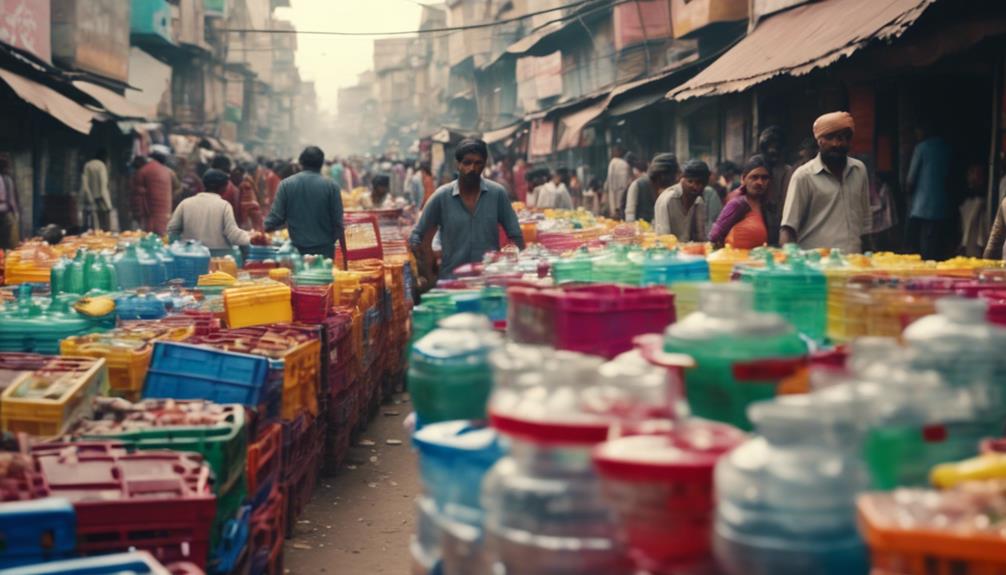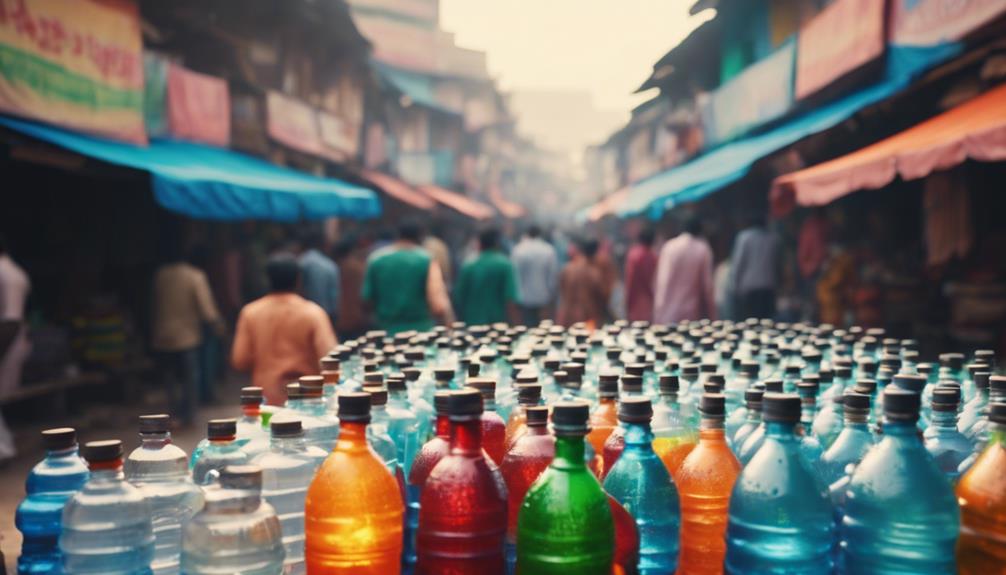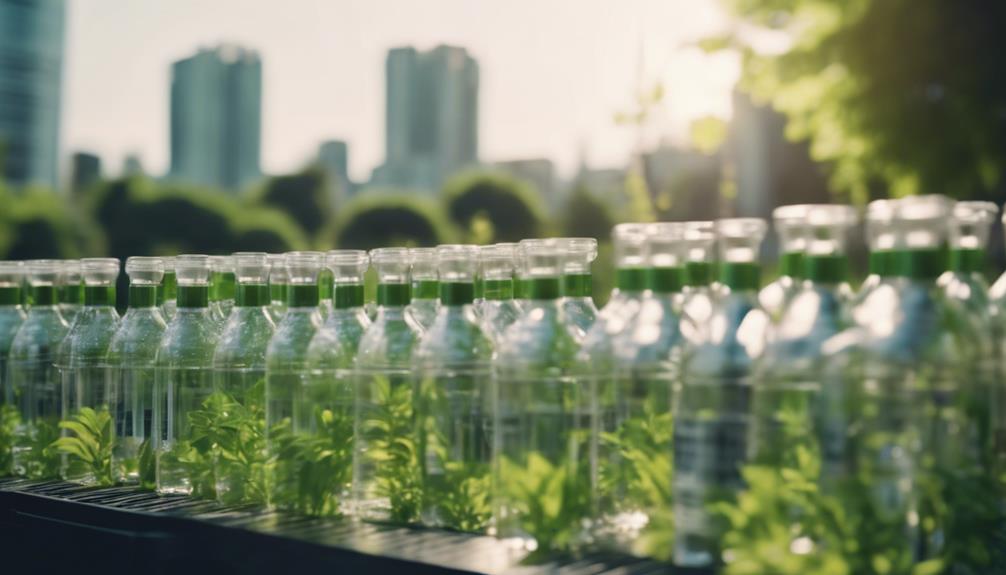India's bottled water market is booming, worth $22.72 billion in 2022 and projected to grow to $36.21 billion by 2030. This growth, driven by rising disposable incomes and increased health consciousness post-COVID-19, has seen significant competition among brands like Bisleri, Coca-Cola, and PepsiCo. Direct-to-consumer models and digital partnerships are enhancing customer engagement, while challenges such as high transportation costs and counterfeit products pose risks. Consumers are increasingly investing in premium options that promise safety and quality. The industry's focus on sustainability and brand loyalty points to a dynamic future ahead, revealing more intricate aspects to explore.
Key Takeaways
- The Indian bottled water market was valued at $22.72 billion in 2022, projected to reach $36.21 billion by 2030 with a 6% CAGR.
- Health consciousness has surged post-COVID-19, driving consumers towards premium bottled water for perceived health benefits.
- Key players like Bisleri and Aquafina dominate the market, with Bisleri holding a 26% market share.
- Distribution challenges, including high transportation costs and counterfeit products, threaten brand reputation and consumer trust.
Market Overview

The bottled water market in India, valued at $22.72 billion in 2022, is poised for substantial growth, projected to reach $36.21 billion by 2030, driven by a compound annual growth rate (CAGR) of 6% from 2023 to 2030.
This market has experienced remarkable growth of 40-45% over the past five years, largely fueled by rising disposable incomes and heightened health consciousness following the COVID-19 pandemic.
Leading players such as Parle Bisleri, Coca-Cola, PepsiCo, and Nestle dominate the landscape, reflecting a blend of both multinational corporations and local manufacturers.
As consumer preferences shift towards safer drinking options, the demand for bottled water continues to expand, marking an exciting phase for the industry in India.
Brand Competition

With the market's rapid expansion, brand competition in India's bottled water sector intensifies as key players vie for consumer loyalty and market share. Major brands are implementing innovative strategies to capture attention amid rising demand.
- Market Share Dynamics: Bisleri leads with a 26% market share, while Aquafina follows at 11%, highlighting the competitive landscape.
- Direct-to-Consumer Models: Brands like Bisleri and Bailley are embracing direct-to-consumer approaches, enhancing customer engagement.
- Digital Expansion: Partnerships with delivery apps have facilitated online sales growth, catering to tech-savvy consumers seeking convenience.
As consumer preferences shift towards health and safety, brands must continually adapt their strategies to maintain a competitive edge in this burgeoning market.
Distribution Challenges

Despite the growing demand for bottled water in India, significant distribution challenges persist, impacting the efficiency of supply chains and brand integrity.
High transportation costs, attributed to the heavy weight of bottled water, strain profit margins and complicate logistics. Additionally, the availability of products often suffers due to the distance from distribution centers, particularly in rural and semi-urban areas.
The prevalence of counterfeit bottled water further undermines consumer trust and brand reputation, complicating efforts to maintain market share.
Furthermore, the unorganized sector dominates manufacturing in these regions, making standardization and quality control difficult.
Addressing these distribution hurdles is vital for established brands to secure their positions in a rapidly growing market.
Consumer Trends

Rising health consciousness among consumers greatly influences the bottled water market, driving increased purchases as urban populations prioritize safe drinking options. This trend is evident through several key factors:
- Willingness to Pay: Consumers are increasingly inclined to invest in premium bottled water, recognizing its health benefits and safety.
- Online Sales Growth: The convenience of home delivery and online purchasing options has expanded consumer access to bottled water, particularly in urban areas.
- Retail Presence: Bottled water is becoming ubiquitous in various retail settings, including roadside shops, reflecting its growing acceptance and demand.
These trends highlight a significant shift in consumer behavior, emphasizing hygiene and safety in beverage choices, particularly in the wake of the COVID-19 pandemic.
Future Prospects

The future prospects of India's bottled water market appear promising, driven by significant investments and a growing focus on sustainability and innovation. Major players like Tata Group are poised to enhance their portfolios, while brands emphasize quality and safety to combat counterfeiting. Expansion of distribution channels—both physical and online—will be essential for capturing market share.
| Key Focus Areas | Strategic Initiatives |
|---|---|
| Sustainability | Eco-friendly packaging solutions |
| Brand Loyalty | Enhanced marketing and consumer engagement |
| Distribution Expansion | Partnership with e-commerce platforms |
These initiatives will not only meet evolving consumer expectations but also solidify the industry's growth trajectory in the coming years.
Conclusion
As the bottled water market in India continues its upward trajectory, a vibrant tapestry of competition, innovation, and consumer awareness emerges.
The interplay of established brands and local enterprises creates a dynamic landscape, while evolving distribution channels reflect changing consumer behaviors.
With health consciousness at the forefront, the future promises not only growth but also a transformation in how hydration is perceived and accessed.
This burgeoning sector is set to quench the thirst for convenience and quality in an ever-evolving marketplace.









